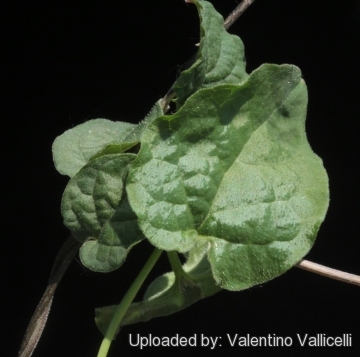
Ceropegia papillata Photo by: Valentino Vallicelli
Origin and Habitat: Occurs in eastern Africa south of the equator in Malawi, Tanzania (Njombe District, Iringa Province, Songea District, Ruvuma Province ), Zaire, and Zambia.
Altitude: 1400 to 3000 m above sea level.
Habitat and ecology: Grows in rocky or grassy mountainous areas, where it scrambles in the surrounding vegetation.
Synonyms:
See all synonyms of Ceropegia papillata
back
Accepted name in llifle Database:Ceropegia papillata N.E.Br.Bull. Misc. Inform. Kew 1898: 308 1898Synonymy: 3
back
Description: It is a tuberous rooted species, with thin scrambling or climbing stems and large and showy flowers.
Tuber (caudex): Globose flattened, 3-5 (or more) centimetres thick with fissured bark
Stems:: Herbaceous, twining, pubescent about 1 m long and 1-2 mm in dimeter.
Leaves: Opposite, simple, narrowly heart-shaped and about 3-6 cm in length and 1-2,5 cm wide, petiole up to 2.5 cm long, base cordate, apex long-acuminate, margin entire, hairy on both sides.
Inflorescence: Subsessile umbel-like cyme. They appear as larger groups of l0-20 flowers between the leaf bases.
Flower: Light Brown/White/Black and quite variable in the coronal structure. Flowers are bisexual, regular, 5-merous, flask-shaped, the lower third of the flower tube is white or dusty whitish coloured bulbous at the base, and abruptly tapered pinkish-brown upward. Sepals linear-lanoeolate, 6 mm long and 1-2 mm wide. The petals are greenish or brightly yellow in colour with maroon edges and white fringe and quite broad.
Remarks: Two varieties have been distinguished based on the form of the outer corona: in var. papillata the lobes of the outer corona are only connate at the base; in var. cordiloba they are completely connate forming a cup which is crenate-denticulate at apex.
Bibliography: Major references and further lectures
1)Focke Albers, Ulrich Meve “Illustrated Handbook of Succulent Plants: Asclepiadaceae” Volume 4 Springer, 2002
 Ceropegia papillata Photo by: Valentino Vallicelli
Ceropegia papillata Photo by: Valentino Vallicelli Ceropegia papillata Photo by: Valentino Vallicelli
Ceropegia papillata Photo by: Valentino VallicelliCultivation and Propagation: It is not difficult to grow in a very draining mineral potting substrate.
Frost Tolerance: Need frost protection. Recommended minimum temperature is 12 °C or even above.
Sun Exposure: Light shade.
Propagation: Seeds.
Traditional uses: Its leaves and also its tuber are used as a vegetable.The tuberous roots and the raw leaves are eaten by boys in the Kota Kota Hills of Malawi. The tubers contain much water and are eaten against thirst in dry regions.












